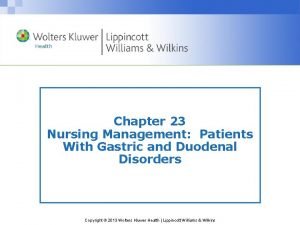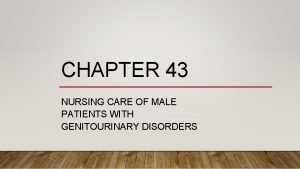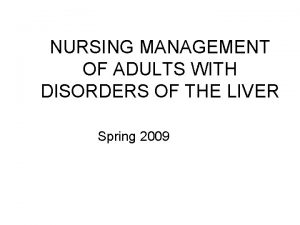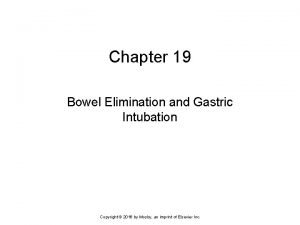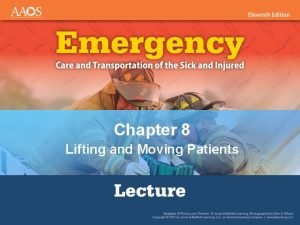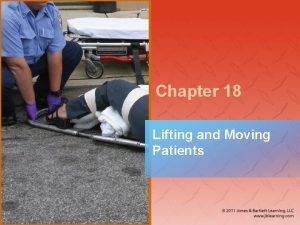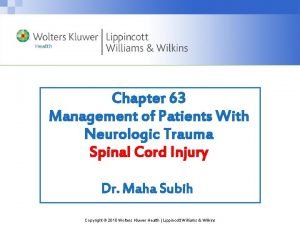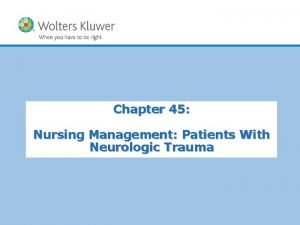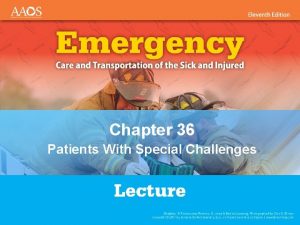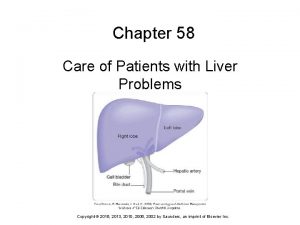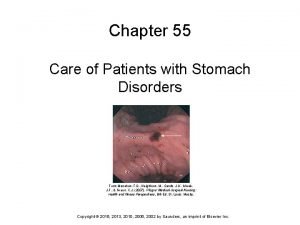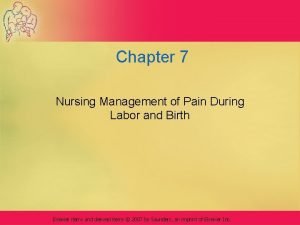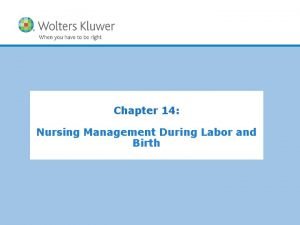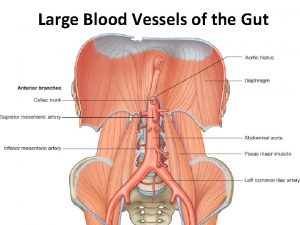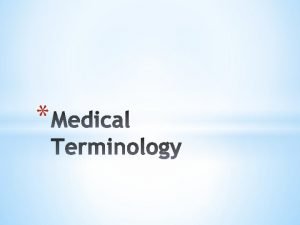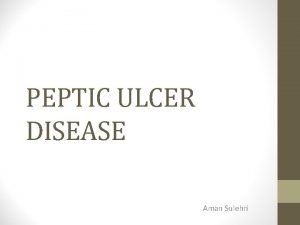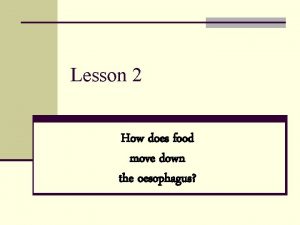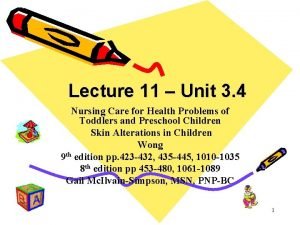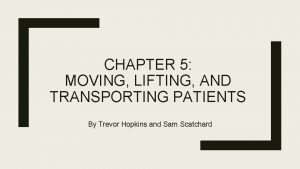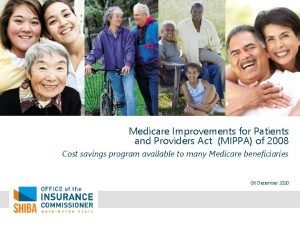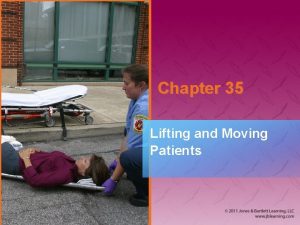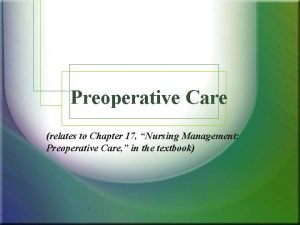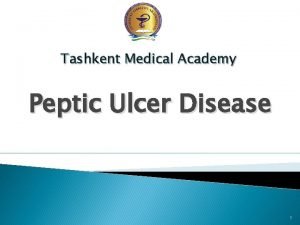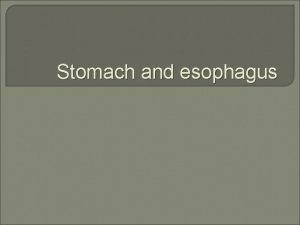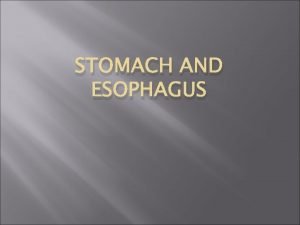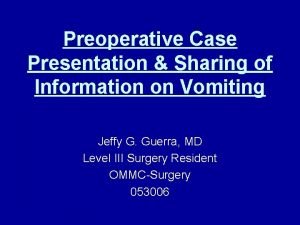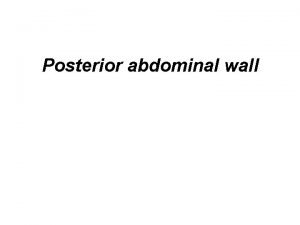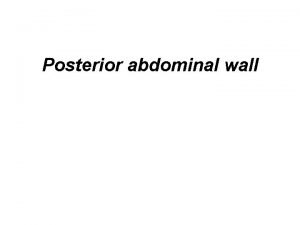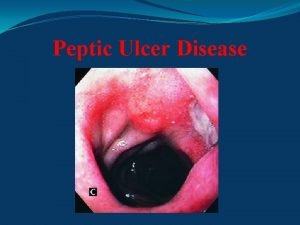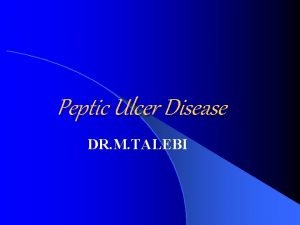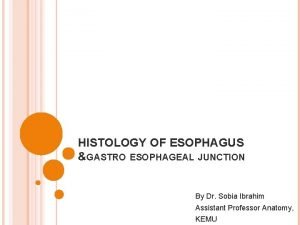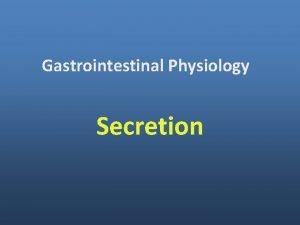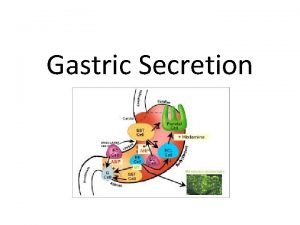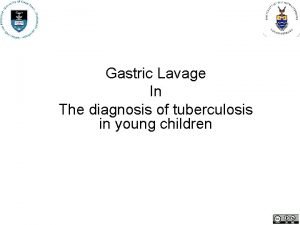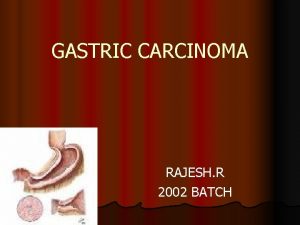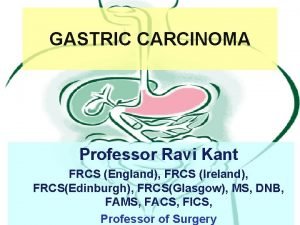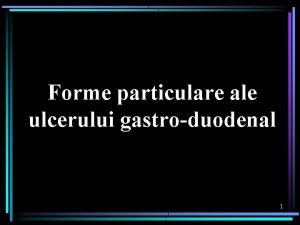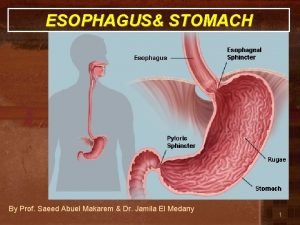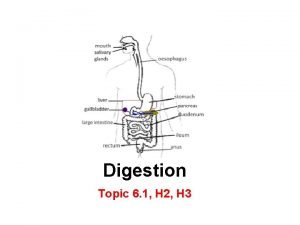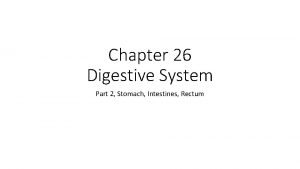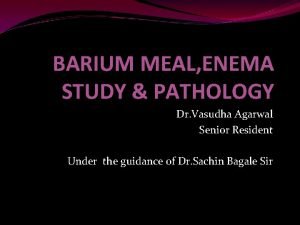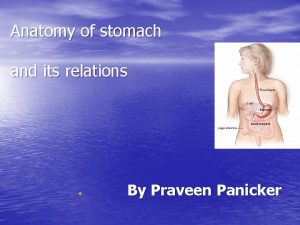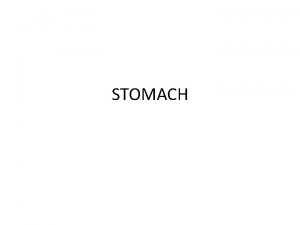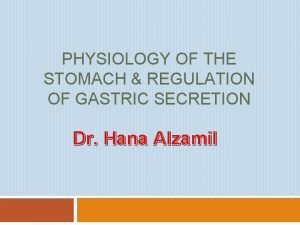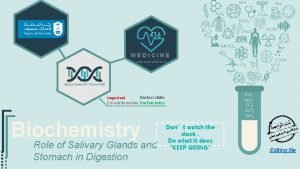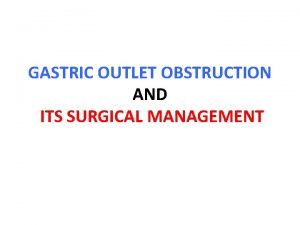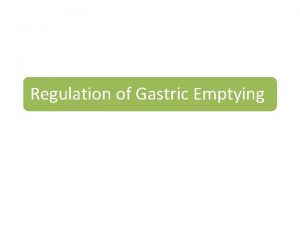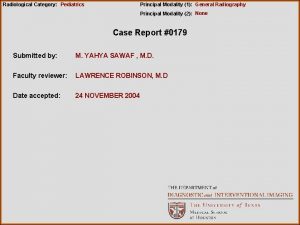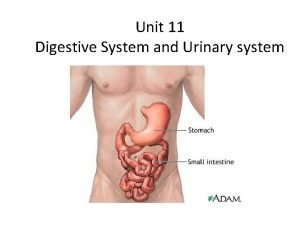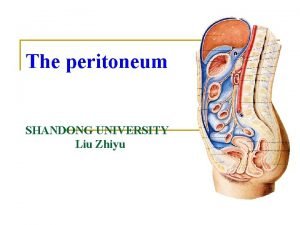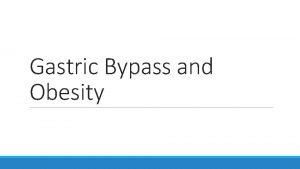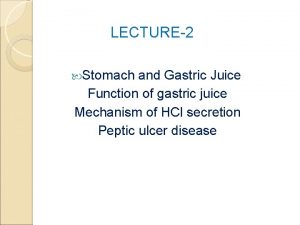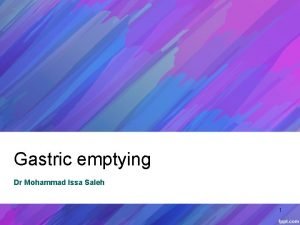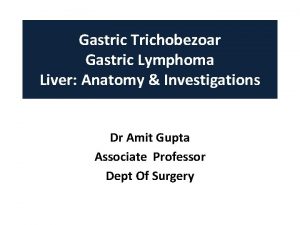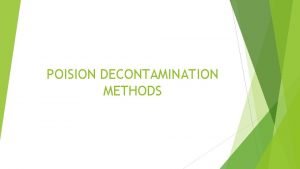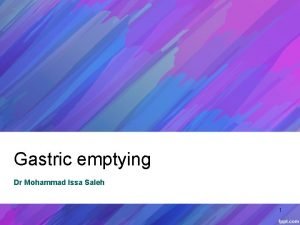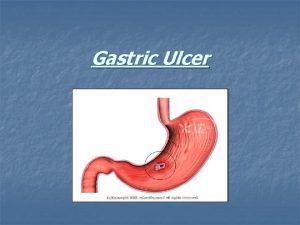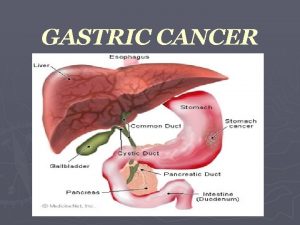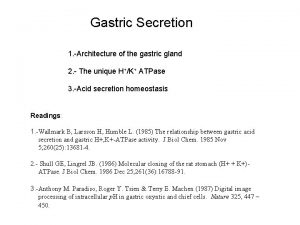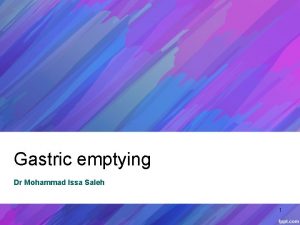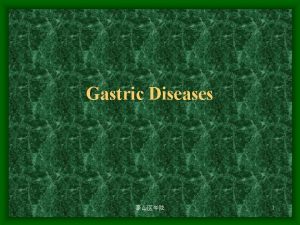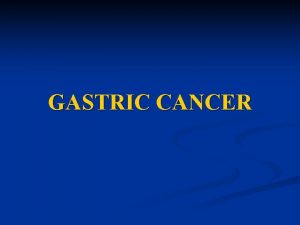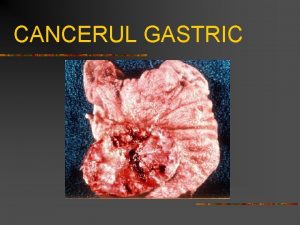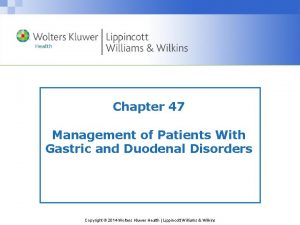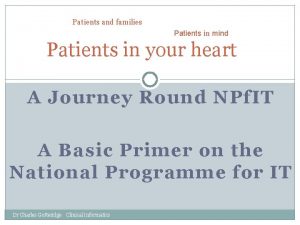Chapter 23 Nursing Management Patients With Gastric and



































































- Slides: 67

Chapter 23 Nursing Management: Patients With Gastric and Duodenal Disorders Copyright © 2013 Wolters Kluwer Health | Lippincott Williams & Wilkins

Gastritis • Inflammation of the gastric mucosa • Types: 1. Acute: Often caused by dietary indiscretion 2. Chronic: May be caused either by benign or malignant ulcers of the stomach or by the bacteria Helicobacter pylori (H. pylori) • Manifestations • Treatment Copyright © 2013 Wolters Kluwer Health | Lippincott Williams & Wilkins

Peptic Ulcer Disease • May be gastric, duodenal, or esophageal • Erosion is caused by increased concentration of HCl or activity of acid-pepsin • Infection from H. pylori bacteria may occur • Stress-related mucosal disease (SRMD): The phenomenon of injury to the lining of the stomach and the duodenum during physiologic stress • Major manifestation is dull, gnawing pain or a burning sensation in the midepigastrium or in the back – Also pyrosis (heartburn), vomiting, constipation or diarrhea, and bleeding Copyright © 2013 Wolters Kluwer Health | Lippincott Williams & Wilkins

Question A patient has been experiencing heartburn in recent months. The nurse knows that a diagnostic workup for peptic ulcer disease will prioritize: A. Family history B. Medication assessment C. Assessing for overconsumption of spicy foods D. Testing for Helicobacter pylori Copyright © 2013 Wolters Kluwer Health | Lippincott Williams & Wilkins

Answer Rationale: H. pylori is causative of peptic ulcer disease. Diet, family history, and medications can also contribute to the disease but the relationship between H. pylori and the disease is more highly significant. Copyright © 2013 Wolters Kluwer Health | Lippincott Williams & Wilkins

Medical and Nursing Management of Peptic Ulcer Disease • Drug treatment focuses on antibiotics, proton pump inhibitors, histamine-2 (H 2) receptor antagonists, and bismuth salts • Life style changes: Stress reduction, smoking cessation, and dietary modifications • Surgery • Nursing interventions address the risks of hemorrhage, perforation, penetration, and pyloric obstruction (gastric outlet obstruction [GOO]) Copyright © 2013 Wolters Kluwer Health | Lippincott Williams & Wilkins

Question Is the following statement true or false? The patient with peptic ulcer disease should be encouraged to eat five to six small meals each day rather than three larger meals. Copyright © 2013 Wolters Kluwer Health | Lippincott Williams & Wilkins

Answer Rationale: For the patient who has peptic ulcer disease, an effort is made to neutralize acid by eating three regular meals a day. Small, frequent feedings are not necessary as long as an antacid or a histamine blocker is taken. Copyright © 2013 Wolters Kluwer Health | Lippincott Williams & Wilkins

Morbid Obesity • A term applied to people: – Who are more than two times their ideal body weight – Whose body mass index (BMI) exceeds 30 kg/m 2 – Who are more than 100 pounds greater than their ideal body weight • Incidence and prevalence are increasing • Associated with higher risk for health complications Copyright © 2013 Wolters Kluwer Health | Lippincott Williams & Wilkins

Morbid Obesity (cont’d) • Conservative management consists of placing the person on a weight loss diet in conjunction with behavioral modification and exercise • Several medications are approved for obesity • Bariatric surgery, or surgery for morbid obesity, is performed only after other nonsurgical attempts at weight control have failed – Complications and nursing care similar to other surgeries but with the additional risks associated with obesity Copyright © 2013 Wolters Kluwer Health | Lippincott Williams & Wilkins

Gastric Cancer • Accounts for almost 11, 000 deaths annually • Prognosis is generally poor: – The diagnosis is usually made late because most patients are asymptomatic during the early stages of the disease • Risk factors • Manifestations • There is no successful treatment except removal of the tumor Copyright © 2013 Wolters Kluwer Health | Lippincott Williams & Wilkins

Question A patient has just been diagnosed with gastric cancer and the nurse is taking a history on this patient. What would be a priority question to ask? A. What is your smoking and alcohol history? B. What is your work history? C. What is your level of fatigue? D. What is your family history of smoking and alcohol use? Copyright © 2013 Wolters Kluwer Health | Lippincott Williams & Wilkins

Answer Rationale: Activities that irritate the stomach, such as smoking and heavy alcohol use, are implicated in the etiology of gastric cancer. Family history of these activities and the patient’s work history and level of fatigue are not relevant. Copyright © 2013 Wolters Kluwer Health | Lippincott Williams & Wilkins

Nursing Process: The Patient Undergoing Gastric Surgery • Preoperative assessment prioritizes nutrition and recent weight changes • Postoperative assessment prioritizes complications such as hemorrhage, infection, abdominal distention, atelectasis, or impaired nutritional status Copyright © 2013 Wolters Kluwer Health | Lippincott Williams & Wilkins

Nursing Interventions: The Patient Undergoing Gastric Surgery • Interventions are aimed at: – Reducing anxiety – Relieving pain – Providing teaching – Resuming enteral intake • Obstacles to nutrition include dysphagia, gastric retention, bile reflux, dumping syndrome, and dietary deficiencies Copyright © 2013 Wolters Kluwer Health | Lippincott Williams & Wilkins

Question Is the following statement true or false? The symptoms of dumping syndrome are precipitated by hypertonic intestinal contents. Copyright © 2013 Wolters Kluwer Health | Lippincott Williams & Wilkins

Answer Rationale: Foods high in carbohydrates and electrolytes must normally be diluted in the jejunum before absorption can take place. In patients experiencing dumping syndrome, the passage of food from the stomach remnant into the jejunum is too rapid. The hypertonic intestinal contents draw extracellular fluid from the circulating blood volume into the jejunum and contribute to the symptoms. Copyright © 2013 Wolters Kluwer Health | Lippincott Williams & Wilkins

Duodenal Tumors • These tumors are uncommon and are usually benign and asymptomatic: – May present insidiously with vague, nonspecific symptoms • Treatment may involve chemotherapy, radiation, or surgery Copyright © 2013 Wolters Kluwer Health | Lippincott Williams & Wilkins

NCLEX-Style Review Questions A 47 -year-old man with epigastric pain is being admitted to the hospital. During the admission assessment and interview, what specific information should the nurse obtain from the patient, who is suspected of having peptic ulcer disease? a. Any allergies to food or medications b. Use of nonsteroidal anti-inflammatory drugs (NSAIDs) c. Past medical history of two generations d. History of side effects of all medications Copyright © 2013 Wolters Kluwer Health | Lippincott Williams & Wilkins

NCLEX-Style Review Questions Rationale: Use of NSAIDs in the patient suspected of peptic ulcer disease increases the risk of GI bleeding. Copyright © 2013 Wolters Kluwer Health | Lippincott Williams & Wilkins

NCLEX-Style Review Questions What assessment finding supports the client’s diagnosis of gastric ulcer? a. Presence of blood in the client’s stool for the past month b. Complaints of sharp pain in the abdomen after eating a heavy meal c. Periods of pain shortly after eating any food. d. Complaints of epigastric burning that moves like a wave Copyright © 2013 Wolters Kluwer Health | Lippincott Williams & Wilkins

NCLEX-Style Review Questions Rationale: Experiencing sharp pain 30 to 60 minutes after meals is common with gastric ulcers; patients with duodenal ulcers can have night pain that is relieved by eating. Copyright © 2013 Wolters Kluwer Health | Lippincott Williams & Wilkins

NCLEX-Style Review Questions Which medication should the nurse question before administering it to a patient with peptic ulcer disease? a. E-mycin, an antibiotic b. Prilosec, a PPI c. Flagyl, an antimicrobial agent d. Tylenol, a nonnarcotic analgesic Copyright © 2013 Wolters Kluwer Health | Lippincott Williams & Wilkins

NCLEX-Style Review Questions Rationale: The antibiotic E-mycin is irritating to the GI tract and should be questioned in a patient with PUD. Copyright © 2013 Wolters Kluwer Health | Lippincott Williams & Wilkins

NCLEX-Style Review Questions The nurse is planning for the discharge of a client with peptic ulcer disease. Which outcome must be included in the plan of care? a. The client’s pain is controlled with NSAIDs. b. The client understands and maintains lifestyle modifications. c. The client takes antacids around the clock. d. The client has no episodes of GI bleeding. Copyright © 2013 Wolters Kluwer Health | Lippincott Williams & Wilkins

NCLEX-Style Review Questions Rationale: Maintaining the lifestyle adjustments of eating an appropriate diet, reducing stress, decreasing or stopping smoking, and following a medication regimen are the goal to treat and prevent complications. Copyright © 2013 Wolters Kluwer Health | Lippincott Williams & Wilkins

NCLEX-Style Review Questions The client with a peptic ulcer is admitted to the hospital’s intensive care unit with obvious gastric bleeding. What is the priority intervention for the nurse? a. Keep an accurate record of intake and output. b. Provide for quiet environment, restrict visitors. c. Prepare the client for an endoscopy. d. Insert a nasogastric tube and begin saline lavage. Copyright © 2013 Wolters Kluwer Health | Lippincott Williams & Wilkins

NCLEX-Style Review Questions Rationale: The goal is to directly stop the bleeding and remove blood/clots/secretions from GI tract so that an endoscopy can be performed and the patient does not vomit and aspirate gastric contents. Copyright © 2013 Wolters Kluwer Health | Lippincott Williams & Wilkins

Chapter 24 Nursing Management: Patients With Intestinal and Rectal Disorders Copyright © 2013 Wolters Kluwer Health | Lippincott Williams & Wilkins

Constipation • An abnormal infrequency or irregularity of defecation • Involves interference with mucosal transport, myoelectric activity, or the processes of defecation • Multiple risk factors (medications, disease, age, low fiber intake) • Treatment focuses on education, bowel habit training, increased fiber and fluid intake, and careful use of laxatives • Complications include hypertension, fecal impaction, hemorrhoids, fissures (tissue folds), and megacolon Copyright © 2013 Wolters Kluwer Health | Lippincott Williams & Wilkins

Question Is the following statement true or false? The first line of intervention for a patient who is experiencing constipation should be a stimulant laxative. Copyright © 2013 Wolters Kluwer Health | Lippincott Williams & Wilkins

Answer Rationale: Because of the potential for dependence, laxatives should normally be introduced after measures such as increased fluid and fiber intake have proven ineffective. Copyright © 2013 Wolters Kluwer Health | Lippincott Williams & Wilkins

Diarrhea • An increased frequency of bowel movements of more than three per day, an increased amount of stool or abnormally liquid stool • Types include secretory, osmotic, and mixed diarrhea • Management is directed at controlling symptoms, preventing complications, and eliminating or treating the underlying disease • Nursing priorities include assessing and monitoring the characteristics and pattern of diarrhea • It is important to monitor serum electrolyte levels closely Copyright © 2013 Wolters Kluwer Health | Lippincott Williams & Wilkins

Fecal Incontinence • The involuntary passage of stool from the rectum • Identification of the underlying cause is vital • Priorities for nursing care include bowel retraining (when possible) and meticulous skin care Copyright © 2013 Wolters Kluwer Health | Lippincott Williams & Wilkins

Irritable Bowel Syndrome • A change in motility caused by a neuroendocrine dysregulation, infection or irritation, or a vascular or metabolic disturbance • Primary symptom is an alteration in bowel patterns • Goals of treatment are relieving abdominal pain, controlling the diarrhea or constipation, and reducing stress Copyright © 2013 Wolters Kluwer Health | Lippincott Williams & Wilkins

Malabsorption • The inability of the digestive system to absorb one or more of the major vitamins, minerals, and nutrients • Multiple risk factors and causes • Typically causes diarrhea or frequent, loose, bulky, foulsmelling stools • Treatment is avoiding dietary substances that aggravate malabsorption and supplementing nutrients that have been lost Copyright © 2013 Wolters Kluwer Health | Lippincott Williams & Wilkins

Question Which of the following health problems may potentially have an etiology that results from the patient’s pre-existing malabsorption syndrome? A. Type 1 diabetes B. Colon cancer C. Osteoporosis D. Stroke Copyright © 2013 Wolters Kluwer Health | Lippincott Williams & Wilkins

Answer Rationale: Individuals with malabsorption may have deficient absorption of minerals, such as calcium. Calcium deficiency is implicated in the development of osteoporosis. Diabetes, stroke, and colon cancer are unlikely to result from malabsorption syndrome. Copyright © 2013 Wolters Kluwer Health | Lippincott Williams & Wilkins

Appendicitis • The appendix becomes inflamed and edematous as a result of becoming kinked or occluded • Immediate surgery is typically indicated if appendicitis is diagnosed • The major complication is perforation of the appendix Copyright © 2013 Wolters Kluwer Health | Lippincott Williams & Wilkins

Diverticular Disease • Diverticulum: A sac-like herniation of the lining of the bowel that extends through a defect in the muscle layer • Diverticulosis: Multiple diverticula are present without inflammation or symptoms • Diverticulitis: Food and bacteria retained in a diverticulum produce infection and inflammation: – Can usually be treated on an outpatient basis with diet and medication. – In acute cases with significant symptoms, hospitalization and surgery may be required Copyright © 2013 Wolters Kluwer Health | Lippincott Williams & Wilkins

Peritonitis • Inflammation of the peritoneum caused by leakage of contents from abdominal organs into the abdominal cavity • Usually a result of bacterial infection • Typical symptoms are an “acute abdomen” • Treatment focuses on fluids, pain relief, and antibiotics • Frequent, vigilant assessment of the acutely ill patient is needed Copyright © 2013 Wolters Kluwer Health | Lippincott Williams & Wilkins

Inflammatory Bowel Disease (IBD) • Refers to two chronic inflammatory GI disorders: Regional enteritis (Crohn’s disease) and ulcerative colitis • Exact causes are unknown • Incidence is increasing Copyright © 2013 Wolters Kluwer Health | Lippincott Williams & Wilkins

Regional Enteritis (Crohn’s Disease) • A subacute and chronic inflammation of the GI tract wall that extends through all layers • Symptoms include prominent lower right quadrant abdominal pain unrelieved by defecation and diarrhea • Weight loss, malnutrition, and secondary anemia often occur • Complications include intestinal obstruction or stricture formation, perianal disease, fluid and electrolyte imbalances, malnutrition from malabsorption, and fistula and abscess formation Copyright © 2013 Wolters Kluwer Health | Lippincott Williams & Wilkins

Ulcerative Colitis • A recurrent ulcerative and inflammatory disease of the mucosal and submucosal layers of the colon and rectum • Characterized by multiple ulcerations, diffuse inflammations, and desquamation or shedding of the colonic epithelium, causing bleeding • Involves a pattern of exacerbations and remissions • Complications include toxic megacolon, perforation, and bleeding Copyright © 2013 Wolters Kluwer Health | Lippincott Williams & Wilkins

Question Is the following statement true or false? Both Crohn’s disease and ulcerative colitis exclusively affect the colon and rectum. Copyright © 2013 Wolters Kluwer Health | Lippincott Williams & Wilkins

Answer Rationale: Ulcerative colitis affects the rectum and descending colon, but Crohn’s disease usually affects the patient’s ileum and ascending colon. Copyright © 2013 Wolters Kluwer Health | Lippincott Williams & Wilkins

Medical and Nursing Management of IBD • Priorities are: – Reducing inflammation – Suppressing inappropriate immune responses – Providing rest for a diseased bowel so that healing may take place – Improving quality of life • Interventions include dietary modifications, medication administration, and postsurgical care Copyright © 2013 Wolters Kluwer Health | Lippincott Williams & Wilkins

Ileostomy • The surgical creation of an opening into the ileum or small intestine • Multiple types • Priorities for postoperative nursing involve skin care, education for device management, nutrition promotion, prevention of complications, and facilitation of coping Copyright © 2013 Wolters Kluwer Health | Lippincott Williams & Wilkins

Question What symptoms may be suggestive of an intestinal obstruction in a patient with an ileostomy? A. Continuous flow of liquid stools and belching B. Hypervolemia and hyperkalemia C. Muscle spasms and numbness of the extremities D. Nausea and abdominal distention Copyright © 2013 Wolters Kluwer Health | Lippincott Williams & Wilkins

Answer Rationale: Nausea and abdominal distention, which may indicate that ileostomy output is blocked. Dehydration and electrolyte deficiencies may occur due to fluid losses through the ileostomy. The drainage from an ileostomy is a continuous liquid from the small intestine because the stoma does not have a controlling sphincter. Numbness of the extremities and belching do not indicate an intestinal obstruction, and muscle spasms may be related to electrolyte deficiencies. Copyright © 2013 Wolters Kluwer Health | Lippincott Williams & Wilkins

Colorectal Cancer • An increasingly common malignancy • May start as a benign polyp but may become malignant, invade and destroy normal tissues, and extend into surrounding structures • Prone to metastasis • Symptoms are often insidious, resulting in late diagnosis and low survival Copyright © 2013 Wolters Kluwer Health | Lippincott Williams & Wilkins

Medical Management: Colorectal Cancer • Treatments include chemotherapy, radiation therapy, and immunotherapy • Surgeries include: – Segmental resection with anastomosis – Abdominoperineal resection with permanent sigmoid colostomy – Temporary colostomy followed by segmental resection and anastomosis – Permanent colostomy or ileostomy – Construction of a colonic J pouch Copyright © 2013 Wolters Kluwer Health | Lippincott Williams & Wilkins

Nursing Care: The Patient With Colorectal Cancer • Priorities include: – Preparing the patient for surgery – Providing emotional support – Maintaining nutrition – Providing wound care – Monitoring and managing complications – Supporting a positive body image – Discussing sexuality issues Copyright © 2013 Wolters Kluwer Health | Lippincott Williams & Wilkins

Intestinal Obstruction Copyright © 2013 Wolters Kluwer Health | Lippincott Williams & Wilkins

Intestinal Obstruction (cont’d) • May occur in the small bowel or large bowel • Small bowel obstruction has a more rapid onset and is treated with nasogastric decompression • Large bowel obstruction has a more gradual onset and may require the creation of a colostomy Copyright © 2013 Wolters Kluwer Health | Lippincott Williams & Wilkins

Diseases of the Anorectum • Anal fistulas (a small opening beside the anus that exptends into the anal canal) and fissures (longitudinal tear or ulceration in the lining of the anal canal) • Hemorrhoids (dilated portions of veins in the anal canal) • Sexually transmitted anorectal diseases (gonorrhea, chlamydia, herpes) • Pilonidal cysts (cyst in the intergluteal cleft on the posterior surface of the lower sacrum) Copyright © 2013 Wolters Kluwer Health | Lippincott Williams & Wilkins

Pilonidal Cyst Copyright © 2013 Wolters Kluwer Health | Lippincott Williams & Wilkins

NCLEX-Style Review Questions A patient returns to his room following a diagnostic colonoscopy after radiological evidence of diverticulosis. He reports an increase in abdominal pain, fever, and chills. Which clinical condition is most concerning to the nurse? a. Colon cancer b. Hemorrhoids c. Bowel perforation d. Anal fissure Copyright © 2013 Wolters Kluwer Health | Lippincott Williams & Wilkins

NCLEX-Style Review Questions Rationale: During a colonoscopy, manipulation of the bowel occurs, which can cause peritonitis or bowel perforation. Signs and symptoms of a perforated bowel include abdominal pain, fever, and chills. The patient may have guarding (not allowing palpation of the abdomen), rigidity, and firmness of the abdomen, or rebound tenderness (an increase of pain upon releasing pressure on the abdomen). Copyright © 2013 Wolters Kluwer Health | Lippincott Williams & Wilkins

NCLEX-Style Review Questions A patient is complaining of right lower quadrant pain, fever, and decreased appetite. The nurse knows that which of the following is the most likely cause? a. Diverticulitis b. Appendicitis c. Small bowel obstruction d. Sigmoid colon cancer Copyright © 2013 Wolters Kluwer Health | Lippincott Williams & Wilkins

NCLEX-Style Review Questions Rationale: The signs and symptoms of appendicitis include right lower quadrant pain, increased fever and WBC counts, and a decreased appetite. The patient may also complain of nausea and vomiting, and the pain may radiate into the umbilical area. Copyright © 2013 Wolters Kluwer Health | Lippincott Williams & Wilkins

NCLEX-Style Review Questions A patient complains of abdominal pain that typically occurs after meals, along with diarrhea that is unrelieved by defecation. The nurse recognizes that which of the following is the most likely diagnosis? a. Ulcerative colitis b. Regional enteritis c. Cholecystitis d. Diverticulosis Copyright © 2013 Wolters Kluwer Health | Lippincott Williams & Wilkins

NCLEX-Style Review Questions Rationale: Regional enteritis, or Crohn’s disease, typically presents with cramp-/spasm-type abdominal pain that worsens after meals. It often also presents with diarrhea. Copyright © 2013 Wolters Kluwer Health | Lippincott Williams & Wilkins

NCLEX-Style Review Questions A patient complains of abdominal pain and distention, fever, tachycardia, and diaphoresis. An abdominal X-ray shows free air under the diaphragm. The emergency department nurse should suspect which condition? a. Intestinal obstruction b. Malabsorption c. Intestinal perforation d. Acute cholelithiasis Copyright © 2013 Wolters Kluwer Health | Lippincott Williams & Wilkins

NCLEX-Style Review Questions Rationale: Free air in the abdomen may result from a perforation of the abdominal organ or any part of the bowel, a tumor, or trauma. Copyright © 2013 Wolters Kluwer Health | Lippincott Williams & Wilkins

NCLEX-Style Review Questions A patient has a bowel perforation from a recent surgery and has now been diagnosed with peritonitis. He has hypoactive bowel sounds, a temperature of 100. 5°F, and an elevated WBC count. To which of the following should the nurse be alert as the most serious potential complication of peritonitis? a. Nausea b. Diarrhea c. Sepsis d. Abdominal tenderness Copyright © 2013 Wolters Kluwer Health | Lippincott Williams & Wilkins

NCLEX-Style Review Questions Rationale: Sepsis is the major cause of death from peritonitis. Shock may result from septicemia or hypovolemia. The inflammatory process may cause intestinal obstruction, primarily from the development of bowel adhesions, and care must be made to closely monitor the patient’s nasogastric tube drainage and input and output. Diarrhea would normally not occur due to intestinal obstruction, which causes decreased peristalsis and decreased bowel movements. Nausea and abdominal tenderness are expected as clinical manifestations of peritonitis. Copyright © 2013 Wolters Kluwer Health | Lippincott Williams & Wilkins
 Ibd nclex questions
Ibd nclex questions What are the positions used in nursing?
What are the positions used in nursing? Cataract surgery nursing care plan
Cataract surgery nursing care plan Nursing diagnosis of obsessive compulsive disorder
Nursing diagnosis of obsessive compulsive disorder Nursing care of male patients with genitourinary disorders
Nursing care of male patients with genitourinary disorders Sengstaken blakemore tube nursing care
Sengstaken blakemore tube nursing care Nursing interventions for stroke patients
Nursing interventions for stroke patients Enema types
Enema types When performing the rapid extrication technique
When performing the rapid extrication technique Types of lifting and moving patients
Types of lifting and moving patients Backboard strapping techniques
Backboard strapping techniques Lippincott williams & wilkins
Lippincott williams & wilkins Management of patients with neurologic trauma
Management of patients with neurologic trauma Periodontal treatment of medically compromised patients
Periodontal treatment of medically compromised patients Patients with special challenges
Patients with special challenges Chapter 58 care of patients with liver problems
Chapter 58 care of patients with liver problems Chapter 55 care of patients with stomach disorders
Chapter 55 care of patients with stomach disorders Chapter 7 nursing management of pain during labor and birth
Chapter 7 nursing management of pain during labor and birth Chapter 14 nursing management during labor and birth
Chapter 14 nursing management during labor and birth Trifoliate deformity duodenal ulcer
Trifoliate deformity duodenal ulcer Celiac trunk branches
Celiac trunk branches Polyadenitis prefix root suffix
Polyadenitis prefix root suffix Ulcer niche and ulcer notch
Ulcer niche and ulcer notch Stomach
Stomach What is this?
What is this? Modular nursing example
Modular nursing example Wendylett sheets 1 carer
Wendylett sheets 1 carer High fowlers position
High fowlers position Patient rights and responsibilities nabh
Patient rights and responsibilities nabh Safe staffing ratios: benefiting nurses and patients
Safe staffing ratios: benefiting nurses and patients Medicare improvements for patients and providers act
Medicare improvements for patients and providers act Ems lifting and moving patients
Ems lifting and moving patients Chapter 17 preoperative nursing management
Chapter 17 preoperative nursing management Gastric glands
Gastric glands Stomach ulcer symptoms
Stomach ulcer symptoms Gastric folds
Gastric folds Lymphatic supply of stomach
Lymphatic supply of stomach Gastric bed
Gastric bed Sportello unico previdenziale
Sportello unico previdenziale Vomiting case presentation
Vomiting case presentation Superficial epigastric vein drains into
Superficial epigastric vein drains into Teochanter
Teochanter Omental foramen of winslow
Omental foramen of winslow Stomach ulcer diet menu
Stomach ulcer diet menu Hpilora
Hpilora Anatomy and physiology of peptic ulcer ppt
Anatomy and physiology of peptic ulcer ppt Esophagus stomach junction histology
Esophagus stomach junction histology Enteropancreatic reflex
Enteropancreatic reflex Gastric acid composition
Gastric acid composition Gastric lavage for tb
Gastric lavage for tb R
R Borrmann classification of gastric cancer
Borrmann classification of gastric cancer Ulcer bulbar definitie
Ulcer bulbar definitie Stomach borders
Stomach borders Gastric juice example
Gastric juice example Pancreas awkward yeti
Pancreas awkward yeti Goose neck deformity
Goose neck deformity Cardiac orifice
Cardiac orifice Blood supply of stomach
Blood supply of stomach The stomach
The stomach Which bacteria gives protection against gastric injury
Which bacteria gives protection against gastric injury Gastric lipase secreted by
Gastric lipase secreted by Succussion splash on epigastrium
Succussion splash on epigastrium What is pyloric pump
What is pyloric pump Pylorus
Pylorus Spire gastric band
Spire gastric band Gastric glands
Gastric glands Infracolic compartment
Infracolic compartment
